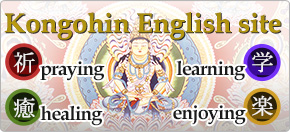Statue of Kobo Daishi Kukai and Sand from the Temples of Shikoku
This statue of Kobo Daishi Kukai (774–835), the founder of Japanese Shingon Buddhism, depicts him during ascetic training.
The pillars around his statue represent the stages of human striving and effort, and the path to enlightenment. The complete cycle also represents the 88 temples often visited by pilgrims in Shikoku—so you can visit the 88 temples even if you don’t have time to go to Shikoku!
As you traverse the cycle clockwise, note that in front of you there is a different stone from each of the areas represented.
The flat stone that you stand on to pray (if you so choose) rests atop sand taken from the temples of that area.
Hosshin (Temples 1–23)
This marks the beginning of your spiritual journey and the awakening of enlightenment in your life.
Shugyo (Temples 24–39)
This represents the training and discipline necessary in endeavors for your spiritual journey.
Bodai (Temples 40–65)
This represents enlightenment. This is also the stage at which it is necessary to pause and reflect, because merely pushing forward with all one’s might will not lead us to the right path.
Nehan (Temples 66–88)
This represents the state of complete self-realization.
To your left are wheels for counting. It is said that making one million of the cycles gives the same merits as completing the 88-temple pilgrimage in Shikoku.




